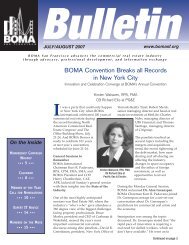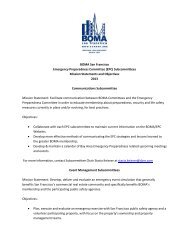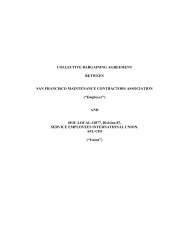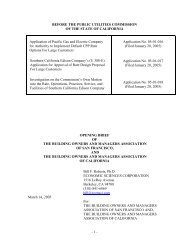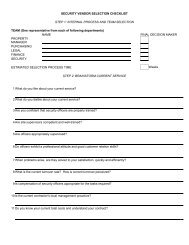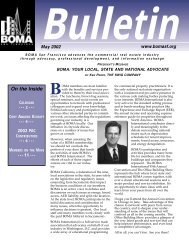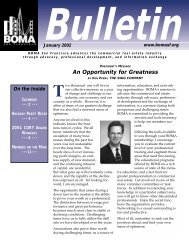Superstorm Sandy Lessons Learned - BOMA SF
Superstorm Sandy Lessons Learned - BOMA SF
Superstorm Sandy Lessons Learned - BOMA SF
Create successful ePaper yourself
Turn your PDF publications into a flip-book with our unique Google optimized e-Paper software.
Hurricane <strong>Sandy</strong> Timeline<br />
Wednesday, October 24<br />
A tropical depression forms in the southern Caribbean Sea off the coast of Nicaragua. The depression<br />
strengthens and becomes Tropical Storm <strong>Sandy</strong> with maximum winds of about 40 mph.<br />
Thursday, October 25<br />
<strong>Sandy</strong> moves north across the Caribbean and hits Jamaica as a Category I hurricane, with 80 mph winds. <strong>Sandy</strong><br />
dumps more than 20 inches of rain on the Dominican Republic and Haiti to its east.<br />
Friday, October 26<br />
<strong>Sandy</strong> moves from Jamaica to Cuba, striking Santiago de Cuba with winds of 110 mph, a strong Category II<br />
hurricane. It crosses the Bahamas and makes a turn to the north-northwest.<br />
Saturday, October 27<br />
Approaching Florida, <strong>Sandy</strong> moves away from the coast and turns northeast, weakening briefly to a tropical<br />
depression but regaining its strength quickly to a Category I hurricane.<br />
Sunday, October 28<br />
<strong>Sandy</strong> moves northeast along a track that parallels Georgia, South Carolina and North Carolina. The hurricane’s<br />
eye remains offshore, but the storm punishes the coastline and North Carolina’s Outer Banks, washing out<br />
highways in places.<br />
Meteorologists warn that the storm will converge with other weather masses, causing a hybrid “super storm.” A<br />
high pressure cold front to the north will block the storm’s northward path, causing it to turn northwest into the mid<br />
Atlantic states. Baltimore, Washington, Philadelphia and New York will be impacted. A corresponding full moon<br />
and high tide will exacerbate the storm surge as it makes land fall. The storm is huge, with winds covering an area<br />
of 1,000 miles. The storm is forecast to dump heavy snow in the mountains of Virginia, West Virginia and North<br />
Carolina.<br />
Monday, October 29<br />
Noon: <strong>Sandy</strong> turns toward the northwest, heading for the Jersey Shore. The storm begins combining with<br />
the other weather systems and gains momentum. <strong>Sandy</strong> will travel 300 miles over open water before landfall,<br />
allowing it to build up a huge storm surge that will become even bigger due to the full moon.<br />
Afternoon: <strong>Sandy</strong> delivers high winds and drenching rains from Washington, D.C. northward. It downs trees,<br />
power lines and halts air and ground traffic.<br />
8 p.m.: <strong>Sandy</strong> makes landfall near Atlantic City, New Jersey. The storm is now classified as a post-tropical<br />
cyclone. As a cyclone, <strong>Sandy</strong>’s strongest winds and highest storm surge are to the front and right of its circulation<br />
as it moves forward. New York Harbor sits in this region, relative to <strong>Sandy</strong>’s path.<br />
The full moon and high tide adds to the storm surge. According to the National Weather Service office in New<br />
York, the surge is close to 14 feet, which is a new record for a storm surge in the harbor. The previous record of<br />
over 10 feet was during Hurricane Donna in 1960. <strong>Sandy</strong>’s massive size delivers winds, rain and flooding during<br />
the night and over the next three high and low tide cycles.<br />
(Source: National Oceanic and Atmospheric Administration (NOAA); National Weather Service (NWS))<br />
Cover Photo: “Hurricane <strong>Sandy</strong> Approaching the East Coast,” October 29, 2012. Credit: NASA/NOAA<br />
v.3/13




